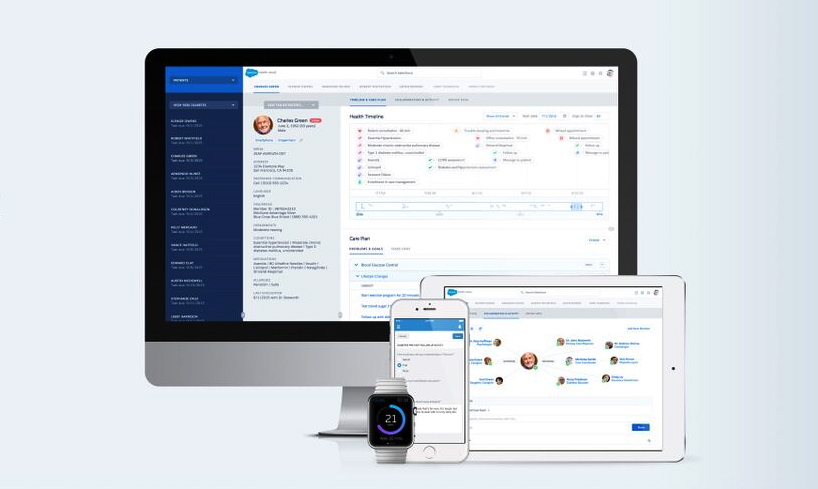It’s undeniable that Salesforce, the San Francisco software company, has transformed how companies in industries as diverse as financial services and higher education manage their customer relationships. Now it’s bringing its cloud-based technology to the world of healthcare.
Salesforce (CRM) announced on Wednesday a new patient relationship management platform that it calls Salesforce Health Cloud. The product is part of the company’s new push to change how doctors and healthcare providers effectively manage the health of patients across caregiver networks.
Salesforce Health Cloud combines data from multiple sources—electronic medical records, medical devices, even wearables—into a single location. The idea? By having all the information in one place, health workers will have a more complete view of the patient and, in turn, be able to make smarter care decisions, intervene earlier if issues arise, and collect data along the way for effective treatments. The software also puts that information in the hands of the patient through mobile applications.
“What gets measured, gets improved,” says Joshua Newman, doctor and chief medical officer for Salesforce’s Healthcare and Life Sciences division. “With everything in one place, now you can see what really affects outcomes. Is it a phone call? A text message? We haven’t had that data before. The things that every business in America thinks about every single day that have never been in healthcare before and are now being brought in by demand.”
A common goal among recently introduced healthcare technologies is the improvement of the patient experience. For example, the industry is transitioning away from a pay-per-service model and toward holistic, outcomes-based reimbursements. Medical offices know that they need to provide more comprehensive care to stay relevant. A first step is collating all of a patient’s pertinent information, regardless of where the care took place.
That’s where Salesforce Health Cloud steps in. The company is working with leading software vendors and systems integrators to tie together existing medical IT systems and layer on Salesforce’s trademark customization.
The challenge with healthcare IT is that most information is stuck in proprietary software silos, hindering the ability to interact across the care spectrum. About 95% of healthcare providers say interoperability challenges limit their ability to transfer data from one medical center to another, according to a study by healthcare alliance Premier. That leaves dangerous gaps in care as information trickles through various IT systems.
Consider a patient who visits an urgent care center for a cough that at first seems benign. The doctor on duty may not know that the patient visited two weeks ago for the same cough and noted shortness of breath during his last physical. If all that information were fed into a single database, a pattern would emerge and—with hope—lead to better diagnosis and treatment.
“Healthcare providers face a significant challenge. To deliver the best patient care possible, they rely on data sitting in multiple systems,” says Ross Mason, founder of billion-dollar software startup MuleSoft, which is working with Salesforce to integrate outside data into the platform. “Connectivity is the key to unlocking this data and making it useful.”
Salesforce Health Cloud has been in development with several health and medical device companies to date, including Centura Health in Colorado, Radboud University Medical Center in the Netherlands, and the University of California, San Francisco. The platform begins previews today and will officially launch in February. Salesforce said it will release pricing for the service at that time.
With hope, Salesforce Health Cloud can bridge the gap and provide a place where various health care providers can interact, including case managers, doctors, nurses, caregivers, and insurance coordinators. It’s a massive task—one that puts the cloud company in league with health companies like Athenahealth (ATHN) and other more-targeted firms like Cardinal Health’s naviHealth (CAH), which focuses on post-acute care coordination.
Sign up for Data Sheet, Fortune’s daily newsletter about the business of technology.
For more Fortune health coverage, watch this video:
[fortune-brightcove videoid=4206626132001]











